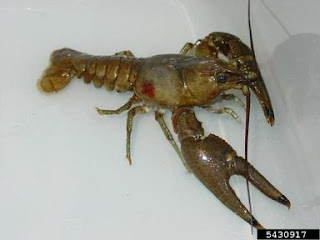Because I introduced some vegetative invasive species in the dendrology post, I decided to look for a impending animal species to the watershed, one of which is the Rusty Crayfish.
Introduced as a bait fish for anglers, the rusty crayfish
has established itself across the Monocacy watershed, out competes the native
crayfish for habitat and food sources, severely impacts the submerged aquatic
vegetation, and generally interrupts the food chain of impacted waterways.
Habitat:
The Rusty Crayfish is Native to the Ohio River basin in Ohio
and Kentucky , prefers warms streams, flat rocks woody debris, and submerged
aquatic vegetation. (SAV). Opportunistic
feeder but mostly focuses on benthic invertebrates, detritus, fish eggs, small
fish and aquatic vegetation.
Have a denser shell than native species, which additionally
removes them from the food chain rather than replace the crayfish that they
push out.
Although the Rusty Crayfish prefers slow freshwater eddies,
it has been found to be saltwater tolerant, which makes it a threat to the
Potomac River and potentially the Chesapeake bay. (MDNR, 2010)
Identification:
Reddish brown spot on posterior sides of carapace with a
smooth, robust chela, and carapace.
Rostral margins with accessory spines.
The rusty had larger more robust claw than native species.
The rusty had larger more robust claw than native species.
Grow to a mature size of 3.5-10 cm and an average length of
6.4 cm (Sea Grant, 2016)
Invasive Characteristics:
·
Displaces native crayfish
·
Reduces the amount and variability of submerged
aquatic vegetation
·
Decreases density and variety of invertebrates
in the ecosystem
·
Reduces some fish populations due to changing
the ecosystem.
There are currently no environmentally sound methods to
eradicate the rusty crayfish. Best practice is to limit or slow their
expansion.
Similar Species includes:
The native Spiny cheek Crayfish (orconectes limosus), and
Alleganey ) Orconectes obscureus) and the virile crayfish (Orconectes virilis
),which is native to the Midwest and Northwest US.
References
MDNR (2010), An
Invasion in Progress: The Spread of Rusty Crayfish in a Maryland Watershed,
Maryland Department of the Environment, Accessed from : dbr2/.maryland.gov/streams/documents/rustycrayfishsurveyfactsheet.pdf
Swecker, C, Jones, T, Killian, J, Roberson, L, (2016), Key
to the Crayfish of Maryland, DNR, Maryland Department of Natural Resources, Key to the Crayfish of Maryland, Accessed from:
dnr.maryland.gov/streams/documents/keytocrayfishesofMD.8_18_10.pdf
Seagrant, (2016) Rusty Crayfish: A nasty Invader, Biology,
Identification, and Impacts, Accessed from:
www.seagrant.umn.edu/ais/rustycrayfish_invader


No comments:
Post a Comment